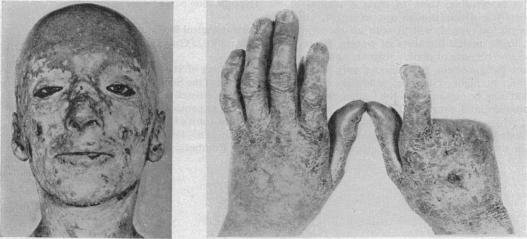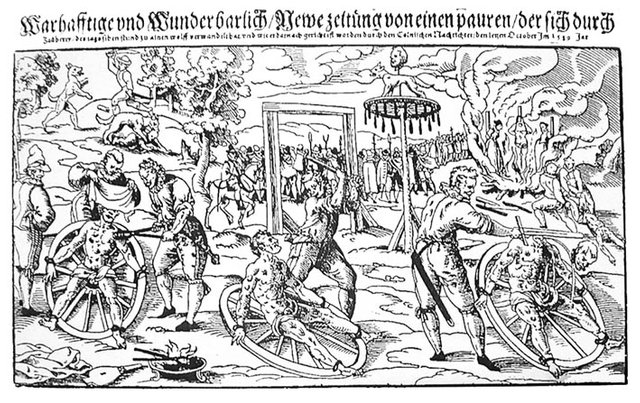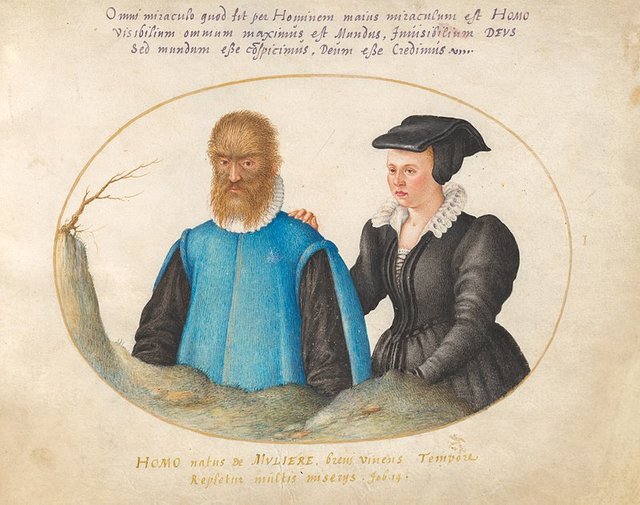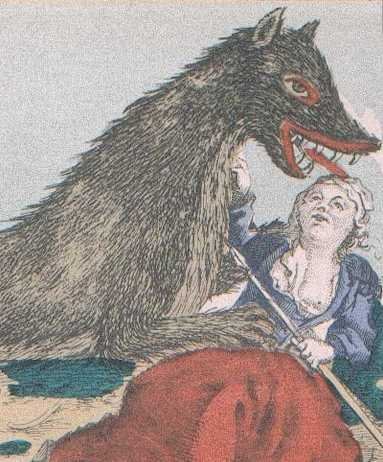31 days of Halloween 2019, Day 5 - Werewolves
You may have noted that days 2-4 are missing, and that I haven't posted the details of the contest yet. Oops, and oops again...I been busy ;> Maybe not always on work, as last night I saw Joker, ate Japanese food, and drove out to Enchanted Rock to look through Astronomical Society telescopes.
But busy nonetheless ;>
And on to the business of werewolves
Halloween contests will be returned to soon

Woodcut of a werewolf attack by Lucas Cranach der Ältere, 1512, Image from Wikimedia Commons
So let's look at werewolves through a couple of lenses, and see why werewolves play a big part of our fears, and thus our Halloweens!
- Commonality through human cultures
- Human medical conditions
- Other Human Causes
- Famous werewolves in history
Werebeasts are COMMON in human mythology and culture
Montague Summers, an English author and clergyman known for his interest in the occult, especially vampires, werewolves, and witches, suggested that the Greeks might have adopted the idea of lycanthropy from an ancient Phoenician cult that dated back to 1200 BC in his study, The Werewolf.
Published in 1933, The Werewolf is one of the first comprehensive books on the subject of werewolves
Gray wolves are common through the Northern hemisphere.

from r/MapPorn, Historical range of Gray wolf
Yet, even in cultures that weren't on first hand acquaintance with wolves, the myths involving weremen of various savage predator origin are common.
Even if there are no wolves on the continent, the culture just substitutes the most ferocious mammalian carnivore they’ve got, according to Caroline Taylor Stewart in her essay “The Origin of the Werewolf Superstition.”
Fantastically Wrong: The Strange Real-Life Origins of the Fiendish Werewolf
Not surprising, as cultures mixed, the myths involving their monsters also merged...
The origin of the lusion legend is found in Guarani mythology. The Guarani are the indigenous people of Paraguay whose mythology stated there were seven monsters. Of the seven monsters, the last one, known as lusion, was horrendously deformed in appearance (but had no apparent resemblance with a wolf), and came to known as the God of Death.)
When the Europeans colonized South America, luison’s association with death began to wane over time. The lusion myth eventually mixed with European werewolf legends. Now the luison is seen as a creature that is half man and half wolf.
Werewolf Legends from Around the World
What kind of human medical conditions may have contributed to werewolf mythology?
- Let's start with the one called "werewolf syndrome", hypertrichosis
There is no link between this condition and savage attacks, but the rare cases of this must have inspired dread in magically-thinking peoples.
Also, check out this pic of an embalmed woman with the condition; note her facial features in conjunction with the disease, and consider how other such cases would have contributed to wolfman mythology.
- Clinical lycanthropy
some people strongly believe they are in the process of metamorphosis into a wolf. There have been 13 case reports of such people since 1850
Real-Life Werewolves: Psychiatry Re-Examines Rare Delusion
There have been cases in which mass killers have been associated with this mental disease (and I'll get to these in a moment), but usually, this mental illness is linked with other conditions such as depression.
Interestingly enough, the condition itself has also been described in medical terms since the Classic ages:
Descriptions of this syndrome are found in the earliest medical writings such as those of the Greek Paulus Aegineta in the seventh century A.D.
Lycanthropy lives on
- Rabies
Savage attacks? Check. Hyperagression? Check. Foaming at the mouth? Check.
Caroline Taylor Stewart
cites the accounts of the America’s Blackfoot people: “It is said that wolves, which in former days were extremely numerous, sometimes went crazy, and bit every animal they met with, sometimes even coming into camps and biting dogs, horses, and people. Persons bitten by a mad wolf generally went mad too. They trembled and their limbs jerked, they made their jaws work and foamed at the mouth, often trying to bite other people.”
Fantastically Wrong: The Strange Real-Life Origins of the Fiendish Werewolf
Rabies may also be behind several other horror myths...
Rabies is a virus transmitted through saliva and so is often contracted from the bites of animals like feral dogs and bats. Once inside the body, it travels to the spinal cord and then onto the brain. Once there it begins to replicate itself inside nerve cells, destroying them in the process. Eventually the virus travels to other parts of the body and causes ‘rabid’ behaviour.
The virus behind the horror legends
We'll tie this back into wolves for just a moment:
Wolves apparently develop the "furious" phase of rabies to a very high degree, which, coupled with their size and strength, makes rabid wolves perhaps the most dangerous of rabid animals
Wolf attack
- Porphyria
Porphyria is another disease that is linked to multiple horror legends, most particularly vampirism.
From On Porphyria and the Aetiology of Werwolves:
The red teeth, the passage of red urine, the nocturnal wanderings, the mutilation of face and hands, the deranged behaviour: what could these suggest to a primitive, fear-ridden,and relatively isolated community?

Image Source -On Porphyria and the AEtiology of Werwolves
- Sociopathic or pyschopathic serial killers
Practically speaking, it doesn't matter which insanity (I don't think "sociopathy" is a recognized disorder in the DSM) a serial killer has if he hacks you open. Quick digression - Note how quick horror movies have gone from traditional monsters to serial killers as humanity has partly "outgrown" monster mythology.
Morton points out that participants at a national symposium on serial homicide conducted by the FBI in 2005 concluded that there is no definitive cause and no generic profile of a serial killer.
Procustes was the first recorded serial killer, stretching out or chopping down his guests in size, so that they might fit his iron bed.
10 Ancient Serial Killers That Foreshadowed Jack The Ripper
And while the hero Theseus eventually sorted Procrustes out, we just have to admit that these loons have been part of our history for a long time. Many of them, as we shall see, were directly linked to or claimed to be werewolves!
Other human causes
Caroline Taylor Stewart makes the argument that prehistorical tribes would decoy themselves as predators in order to lure in and eliminate food chain rivals, and that this practice also played a part in wolfman mythos.
We can also look to recorded history and see human warriors take on predator aspects for combat with other humans.
The Viking beserkers' name derives from the Old Norse words for "coat" or "shirt," and "bear."
The beserkers also added a little animal behavior into their warmaking...
This condition is said to have begun with shivering, chattering of the teeth, and chill in the body, and then the face swelled and changed its colour. With this was connected a great hot-headedness, which at last gave over into a great rage, under which they howled as wild animals, bit the edge of their shields, and cut down everything they met without discriminating between friend or foe.
Grendel and Berserkergang
I'll leave the Vikings with the thought that berserkers took on bear or wolf aspects at their own discretion.
Returning to Steward,
The Pawnee people were called “wolves” by neighboring tribes for their spies’ habit of wearing a hide and sneaking around like the famously cunning predator. Thus, argues Stewart, “the idea of the harmfulness to other men of a man in animal disguise became deeply seated now.”
Fantastically Wrong: The Strange Real-Life Origins of the Fiendish Werewolf
Going past the ubiquitous wolf, we can look to the Aztecs and their Jaguar Knights for another angle on this idea.
- Primal fear
Listen to that.
Pretty cool, right?
Now listen to it when you are cold and hungry, warmed only by a fire that you have to go out into the cold dark night to find more wood to feed. When you go out into that darkness, surrounded by those howls, you only have a stick with a sharp end on it to defend yourself.
Still pretty cool?
;>
Wolf attacks on humans may be rare, but it appears that wolves attacked humans (children in particular) more frequently prior to the common use of firearms.
Real (???) Werewolves
- Gilles de Rais
Gilles was a French noble who was executed in 1440 for the murders of between 140-600 children. The Reverend Sabine Baring-Gould in his Book of Werewolves in 1865 more for Rais' savage crimes than any actual link to lycanthropy. According to the website gillesderaiswasinnocent, the good Reverend was a few pages short in completing his book, and so made a "link" between Gilles' looks and werewolves.
- Peter Stumpp, "the Werewolf of Bedburg",
He was executed on Halloween in 1589. He had confessed to having made a deal with Satan in which he received a belt which allowed him to take the form of a great wolf; in which form that confessed to eating 14 children and 2 pregnant women.
It is likely that Stumpp was a victim of a political trial during religious controversy in the Holy Roman Empire between Catholics and Protestants. It is also interesting that the events took place during a bout of the Plague.
List of serial killers before 1900

Composite woodcut print by Lukas Mayer of the execution of Peter Stumpp in 1589 at Bedburg near Cologne. Wikimedia Commons
- Gilles Garnier, "The Werewolf of Dole".
Another Gilles, he was executed in 1574 after getting caught attacking a child. He confessed to killing and eating 4 children. He stated that a spectre had given him an ointment that allowed him to take "loup-garou" form.
List of serial killers before 1900
- The Beast of Gévaudan
...committed 210 attacks against humans between 1764 and 1767. There may have been more than one Beast, and about half of those attacked died were partially eaten. The king sent out several parties to kill these man-eating animals. "The Beast" was killed several times, with attacks happening after supposed victory.
Karl-Hans Taake makes the argument that The Beast was a male lion in this article
Solving the Mystery of the 18th-Century Killer “Beast of Gévaudan”
- Manuel Blanco Romasanta.
The Werewolf of Allariz was both Spain's first recorded serial killer, and the first known connection between mass murder and clinical lycanthropy. Admitted to 13 murders of women and children and sentenced to death. His execution was commuted by Royal decree in order that a hypnotist be allowed to study his mental state. Died soon after arriving at the prison.
List of serial killers before 1900
- Austin Harouff
After murdering a couple, Austin was arrested on the scene.
When sheriff’s deputies arrived on scene they reported discovering Harouff, then 19, lying on top of [withheld], growling and chewing on his face
New Case of Lycanthropy From an Accused Man-Beast
The year?
2019
Conclusion
From Western to Eastern legends, the dangerous (and hungry!) talking wolf has played it's part. One of the early versions of the Little Red Riding Hood story specifically note a werewolf as a villain, and the scholar in the Chinese story, The Wolf of Zhongshan, barely escapes the consequences of his own do-gooding.
I don't think that the werewolf idea can be traced to any singlecause. Start with a healthy fear of predators (focusing on wolves), add in the use of animal sympathy "magic" for war and hunting, throw in a few medical outliers, let rabies infect a couple of people, don't forget the ever-present risk of murderous lunatics, and let individual cases stack up on the legends of previous cases by oral history. Now mix in the legends of OTHER people when cultures collide.
Presto! you have the Wolfman!
And a final word...
Myths define who we are. They explain things we might not want to look at, or can't explain otherwise.
But maybe they should be taken with a grain of salt in some circumstances; from the TV show Barney Miller, where a man turns himself in before he becomes a werewolf...
Happy Halloween ;>
Suggested reading
Stewart, C. (1909) The Origin of the Werewolf Superstition. The University of Missouri Studies. Vol. 2, no. 3.
List of serial killers before 1900
Morton, R.J. 2005. Serial Murder: Multi-Disciplinary Perspectives for Investigators. National Center for the Analysis of Violent Crime. Washington, D.C.: U.S. Department of Justice.


Hi, @stevescoins!
You just got a 1.11% upvote from SteemPlus!
To get higher upvotes, earn more SteemPlus Points (SPP). On your Steemit wallet, check your SPP balance and click on "How to earn SPP?" to find out all the ways to earn.
If you're not using SteemPlus yet, please check our last posts in here to see the many ways in which SteemPlus can improve your Steem experience on Steemit and Busy.
Hi @stevescoins!
Your post was upvoted by @steem-ua, new Steem dApp, using UserAuthority for algorithmic post curation!
Your UA account score is currently 5.616 which ranks you at #530 across all Steem accounts.
Your rank has not changed in the last three days.
In our last Algorithmic Curation Round, consisting of 87 contributions, your post is ranked at #48.
Evaluation of your UA score:
Feel free to join our @steem-ua Discord server